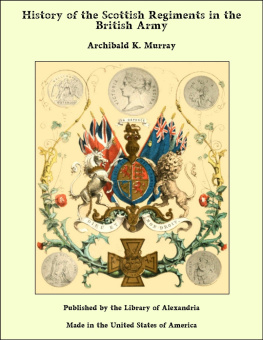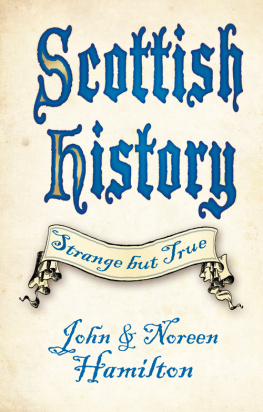NEW PERSPECTIVES IN SCOTTISH LEGAL HISTORY
NEW PERSPECTIVES IN SCOTTISH LEGAL HISTORY
Edited by
ALBERT KIRALFY
and
HECTOR L. MACQUEEN
First published 1984
FRANK CASS AND COMPANY LIMITED
This edition published 2013 by Routledge
2 Park Square, Milton Park, Abingdon, Oxon OX14 4RN
711 Third Avenue, New York, NY 10017, USA
Routledge is an imprint of the Taylor & Francis Group, an informa business
Copyright 1984 Frank Cass & Co. Ltd.
British Library Cataloguing in Publication Data
New perspectives in Scottish legal history.(Journal of legal history, ISSN 0144-0365 ; v.4, no.3)
1. Law Scotland History
I. Kiralfy, Albert II. MacQueen, Hector L.
II. Series
344.1107 KDC330
ISBN 0-7146-3251-1
This group of studies first appeared in a Special Issue on New Perspectives in Scottish Legal History of The Journal of Legal History, Vol. 4, No. 3, published by Frank Cass and Co. Ltd.
All rights reserved. No part of this publication may be reproduced, stored in a retrieval system, or transmitted in any form , or by any means, electronic, mechanical, photocopying, recording, or otherwise, without the prior permission of the publisher.
CONTENTS
W.J. Windram and H.L. Mac Queen |
H.L. MacQueen |
A.J. Mac Lean |
John W. Cairns |
J.W. CAIRNS, LL.B., Ph.D., is a lecturer in Jurisprudence in the Queens University of Belfast. His thesis concerned the legal history of Louisiana and Quebec and he has published articles on comparative law. His study of Blackstones place in the history of legal literature, provisionally entitled Blackstone, an English Institutist: Legal Literature and the Rise of the Nation State, is forthcoming.
A.J. MACLEAN, LL.B., is a lecturer in Scots Law in the University of Edinburgh. He is the author of Jeremy Bentham and the Scottish Legal System, Juridical Review 24 (1979) 21-44 and various other contributions to legal journals. He is currently completing a Ph.D. thesis on the House of Lords and Scots law.
H.L. MACQUEEN, LL.B., is a lecturer in Scots Law in the University of Edinburgh. He is the author of The Brieve of Right in Scots Law, Journal of Legal History 3 (1982) 52-70 and various other contributions to legal journals. An article on Jurisdiction in Heritage and the Lords of Council and Session after 1532 is forthcoming. He is secretary of the Scottish Legal History Group and is currently completing a Ph.D. thesis on the royal courts of medieval Scotland.
W.J. WINDRAM, LL.B., graduated in Law with Scottish History from the University of Edinburgh. Following research on the surviving MSS. of medieval Scots law, he is now completing a legal apprenticeship. He is producing a critical edition of Liber de Judicibus and has published various works on Scottish local history, including Mylnes Court: 300 Years of Lawnmarket Heritage (with R.M. Pinkerton, University of Edinburgh, 1983).
W.J. WINDRAM, and H.L. MACQUEEN
Introduction
It is just under fifty years since the Stair Society published its first volume, An Introductory Survey of the Sources and Literature of Scots Law (SS vol. 1, 1936). The work intended to list the materials from which the history of Scots law might eventually be written and to identify those which the Society itself might undertake to edit and publish. It was divided into four principal sections: (1) Native Sources; (2) Non-Native Sources; (3) Indirect Sources; and (4) Special Subjects. Within each section there were a number of articles on particular topics by various authors. Each article contained three parts: (I) a list of sources, published and unpublished, (2) a commentary and (3) a note of the secondary literature on the topic. The result has been described as outstanding by an eminent historian, and the book remains an essential guide for anyone undertaking historical studies in the field of Scots law. In the half-century since its appearance, however, much scholarly work and research has been undertaken and inevitably many of the articles in Sources and Literature are now incomplete and out-of-date.
Several bibliographical surveys and guides to the sources of general Scottish history have since been published; good recent examples are B. Webster, Scotland from the Eleventh Century to 1603 (Sources of History Ltd. 1975) and G. Donaldson, Sources of Scottish History (Edinburgh 1978), while the bibliographies appended to the four volumes of the Edinburgh History of Scotland should also be mentioned here. We are also conscious of having exercised a degree of subjective judgment in selecting some publications for inclusion whilst excluding others; the basis of decision has been to ask whether a work can or cannot be regarded as a contribution to the understanding of Scottish legal history. Only very exceptionally are volumes included which merely touch incidentally upon law. It should be noted that some of the article headings in Sources and Literature are omitted here (i.e. numbers 4, 20, 21, 24, 26 and 27), on the basis that there appears to be little or nothing to add to the lists made in 1936.
For the sake of brevity in citation the abbreviations listed below have been used:
SS | Stair Society |
JR | Juridical Review |
SLT (News) | Scots Law Times, News section |
SHR | Scottish Historical Review |
SHS | Scottish History Society |
SRS | Scottish Record Society |
A. Native Sources
(i) The Statutory Law. Some minor additions have been made to the collections of statutes in print by W.C. Dickinson, The acts of the parliament at Perth 6 March 1429/30, SHR 29 (1950) 1-12, A.A.M. Duncan, Councils general 14041423, SHR 35 (1956) 132-143 and I.E. O Brien, The Scottish Parliament in the Fifteenth and Sixteenth Centuries (Glasgow Ph.D., 1980) and appendices. There seems to be only one commentary on statutes as sources, by N. Gow, The character of Scots acts, JR 7 (1962) 36-54, which deals with the period 14241707. Lord Cooper drew attention to the difficulties of interpreting legislation attributed to Scottish kings before 1250 in Early Scottish statutes revisited, JR 64 (1952) 197-203 (reprinted in his Selected Papers (Edinburgh 1957) 237-243). F.J. Shaw, Sumptuary legislation in Scotland, JR 24 (1979) 81-115 analyses a series of legislative provisions in one field from 1430 to 1707. Lord Cooper, The first Law Reform (Miscellaneous Provisions) Act, JR 56 (1944) 1-5, reprinted Selected Papers 88-92, is a short commentary on provisions of the 1318 statutes of Robert I. Analyses of the legislation of any given period will usually be found in histories thereof.
(ii) Early Records of Council and Session. The Stair Society has published two volumes drawn from these records, Acta Dominorum Concilii 15011503 ed. J.A. Clyde (SS vol. 8) and Acta Dominorum Concilii et Sessionis 15321533 ed. I.H. Shearer (SS vol. 14). The records of three sixteenth century cases have been fully edited: see Wigtownshire Charters ed. R.C. Reid (SHS, 3rd ser. vol. 51) 137-146, I.D. Grant, Not improven: Advocate and Leslie v. Brown and Johnston 1582 (SS vol. 26, 94-124) and J. Durkan, The royal lectureships under Mary of Lorraine, SHR 62(1983) 73-78. The starting point for all discussion of the origins of the Court of Session is now A. A.M. Duncan, The central courts before 1532 (SS vol. 20, 321-340), but there is still much to be learned from A.R.G. Macmillan,












